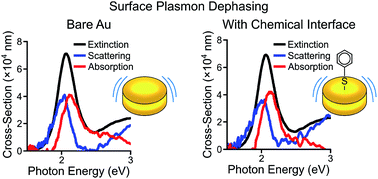当前位置:
X-MOL 学术
›
Faraday Discuss.
›
论文详情
Our official English website, www.x-mol.net, welcomes your
feedback! (Note: you will need to create a separate account there.)
Impact of chemical interface damping on surface plasmon dephasing
Faraday Discussions ( IF 3.3 ) Pub Date : 2018-10-26 , DOI: 10.1039/c8fd00151k Andrew J. Therrien 1, 2, 3, 4 , Matthew J. Kale 4, 5, 6, 7 , Lin Yuan 4, 8, 9, 10, 11 , Chao Zhang 4, 9, 10, 11, 12 , Naomi J. Halas 4, 9, 10, 12, 13 , Phillip Christopher 1, 2, 3, 4
Faraday Discussions ( IF 3.3 ) Pub Date : 2018-10-26 , DOI: 10.1039/c8fd00151k Andrew J. Therrien 1, 2, 3, 4 , Matthew J. Kale 4, 5, 6, 7 , Lin Yuan 4, 8, 9, 10, 11 , Chao Zhang 4, 9, 10, 11, 12 , Naomi J. Halas 4, 9, 10, 12, 13 , Phillip Christopher 1, 2, 3, 4
Affiliation

|
The excellent light harvesting ability of plasmonic nanoparticles makes them promising materials for a variety of technologies that rely on the conversion of photons to energetic charge carriers. In such applications, including photovoltaics and photocatalysis, the excitation of surface plasmons must induce charge transfer across the metal–adsorbate or metal–semiconductor interface. However, there is currently a lack of molecular level understanding of how the presence of a chemical interface impacts surface plasmon dephasing pathways. Here, we report an approach to quantitatively measure the influence of molecular adsorption on the spectral shape and intensity of the extinction, scattering, and absorption cross-sections for nanostructured plasmonic surfaces. This is demonstrated for the case of thiophenol adsorption on lithographically patterned gold nanodisk arrays. The results show that the formation of a chemical interface between thiophenol and Au causes surface plasmons to decay more prominently through photon absorption rather than photon scattering, as compared to the bare metal. We propose that this effect is a result of the introduction of adsorbate-induced allowable electronic transitions at the interface, which facilitate surface plasmon dephasing via photon absorption. The results suggest that designed chemical interfaces with well-defined electronic structures may enable engineering of hot electron distributions, which could be important for understanding and controlling plasmon-mediated photocatalysis and, more generally, hot carrier transfer processes.
中文翻译:

化学界面阻尼对表面等离激元相移的影响
等离子体纳米颗粒具有出色的光收集能力,使其成为各种技术的有前途的材料,这些技术依赖于将光子转换为高能电荷载体。在包括光伏和光催化在内的此类应用中,表面等离激元的激发必须引起电荷穿过金属-被吸附物或金属-半导体界面的转移。但是,目前缺乏对化学界面的存在如何影响表面等离激元相移途径的分子水平的了解。在这里,我们报告了一种方法,用于定量测量分子吸附对纳米结构等离子体表面的消光,散射和吸收截面的光谱形状和强度的影响。对于在光刻图案化的金纳米盘阵列上吸附苯硫酚的情况,证明了这一点。结果表明,与裸金属相比,硫酚和Au之间的化学界面的形成导致表面等离子体激元通过光子吸收而不是光子散射更加显着地衰减。我们认为,这种效应是在界面处引入吸附物诱导的允许电子跃迁的结果,该跃迁有助于表面等离子体激元相移通过光子吸收。结果表明,设计的具有明确定义的电子结构的化学界面可以实现热电子分布的工程设计,这对于理解和控制等离激元介导的光催化以及更普遍的是热载流子转移过程可能非常重要。
更新日期:2019-05-29
中文翻译:

化学界面阻尼对表面等离激元相移的影响
等离子体纳米颗粒具有出色的光收集能力,使其成为各种技术的有前途的材料,这些技术依赖于将光子转换为高能电荷载体。在包括光伏和光催化在内的此类应用中,表面等离激元的激发必须引起电荷穿过金属-被吸附物或金属-半导体界面的转移。但是,目前缺乏对化学界面的存在如何影响表面等离激元相移途径的分子水平的了解。在这里,我们报告了一种方法,用于定量测量分子吸附对纳米结构等离子体表面的消光,散射和吸收截面的光谱形状和强度的影响。对于在光刻图案化的金纳米盘阵列上吸附苯硫酚的情况,证明了这一点。结果表明,与裸金属相比,硫酚和Au之间的化学界面的形成导致表面等离子体激元通过光子吸收而不是光子散射更加显着地衰减。我们认为,这种效应是在界面处引入吸附物诱导的允许电子跃迁的结果,该跃迁有助于表面等离子体激元相移通过光子吸收。结果表明,设计的具有明确定义的电子结构的化学界面可以实现热电子分布的工程设计,这对于理解和控制等离激元介导的光催化以及更普遍的是热载流子转移过程可能非常重要。











































 京公网安备 11010802027423号
京公网安备 11010802027423号